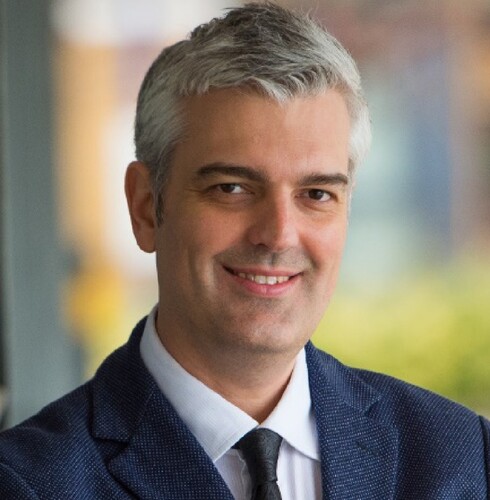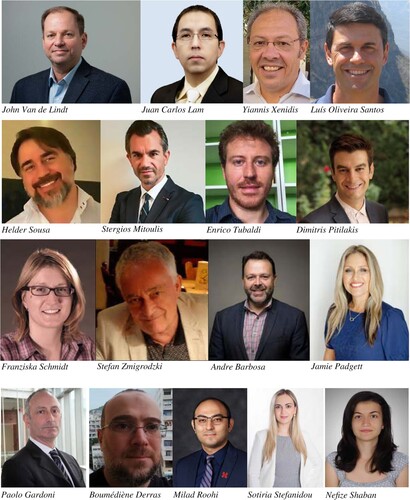Please introduce yourselves to our SEI readers.
Nisrine Makhoul:
My name is Nisrine Makhoul. I am currently an Associate Professor and Head of the Research Team «Smart, Sustainable, and Resilient Cities» at École Spéciale des Travaux Publics, du Bâtiment et de l’Industrie (Special School of Public Works, Building and Industry), ESTP Paris, at Campus of Dijon.
I earned a Ph.D. in 2010 from Ecole Nationale Supérieure d’Arts et Métiers (ENSAM – Paris). I hold a Research Master's degree from ENSAM – Paris and a Civil Engineering Master's from the Lebanese University. After my Ph.D., I had several academic positions (Assistant Professor, Lecturer, etc.) at the University of Balamand, Notre Dame University – Louaize, and Politecnico di Milano. I was a visiting researcher in Mines – ParisTech, University of Grenoble – Alpes, and IFSTTAR. I also have five years of practical experience as an infrastructure and road engineer.
My research focuses on earthquake risk assessment, loss estimations, resilience engineering, and structural health monitoring. I led numerous research projects and was involved with several European research groups. I am a Resilience Fellow at the 4TU. Resilience Engineering Center. I received in the year 2016 the « Franco-Lebanese Scientific Excellence Award of the Society of the Members of the Legion of Honor ».
My story with IABSE started when I joined IABSE in 2010 as a Ph.D. student while participating in the IABSE Symposium Venice 2010. Since then, I have regularly participated in IABSE Conferences (Geneva 2015, Stockholm 2016, Bath 2017, Nantes 2018, Guimarães 2019, and Istanbul 2023), where I have extensively published and led Special Sessions. Following encouragement from the Chair of IABSE Commission 1, Dr. Niels Peter Høj, and the Vice Chair, Dr. Ana Mandic Ivankovic, I have established the Task Group TG1.8, which I chair. I am grateful to colleagues of worldwide reputation who accepted to join the TG1.8 and share their knowledge. I am a Core member of the IABSE Commission 1 and am also involved in TG1.3 and TG1.5.
Sotirios Argyroudis:
My name is Sotirios Argyroudis, and I am an Associate Professor (Reader) of Infrastructure Engineering at Brunel University London. I have previously worked at the University of Surrey as a Marie-Skłodowska-Curie senior research fellow and at the Aristotle University of Thessaloniki, Greece, as senior research and teaching staff. I am a Fellow of the Higher Education Academy, UK (FHEA) and a member of the Institution of Civil Engineers (UK). I have over 20 years of experience in vulnerability, disaster risk and resilience assessment of critical infrastructure exposed to multiple hazards and climate change effects. I participated in and won important national and European research projects on critical infrastructure, and I am currently the Deputy Scientific Coordinator of the Horizon/UKRI ReCharged project. I co-founded the www.bridgeUkraine.org initiative, aiming at accelerating Ukraine's critical infrastructure recovery, and I co-lead the www.infrastructuResilience.com. I have authored over 120 project reports, scientific articles and book chapters, and I have been awarded the 2022 European Council on Computing in Construction (EC3) Thorpe Medal. I am the vice-chair of IABSE TG1.8.
How would you define ‘infrastructure resilience’ in this context?
Resilience engineering is a multidimensional approach aimed at (1) Strategic planning and preparation of infrastructure to withstand disruptive abrupt events and chronic stressors. This proactive approach involves strategic investments and measures to ensure robustness. (2) Inclusive design of infrastructure assets and systems not only to absorb shocks and stresses resulting from unforeseen events but also to maintain their functionality during these events, (3) Enhancing recovery capability to recover swiftly from disruptive incidents and minimise downtimes, and (4) Adaptive response to threats, where infrastructure is designed to dynamically respond to emerging threats, while lessons learned from past events are incorporated for continuous improvement of infrastructure.
Resilience quantification is an essential tool in assessing the performance of infrastructure assets, systems, and communities subsequent to disruptive events (e.g., earthquakes, tsunamis, flooding) and chronic stressors (e.g., climate change, system ageing). This assessment is crucial in informing decision-making processes and resource allocation to accelerate the recovery of infrastructure systems and communities. This quantification approach is applied across various levels, from individual components to entire cities. It considers the interdependencies between these levels, even under the complex scenarios of cascading events. For example, the closure of a bridge due to an extreme flooding event might prevent the accessibility to a hospital or the recovery of a power station. Furthermore, these analyses extend to encompass socio-economic impacts on community resilience. This broader perspective aids in informed decision-making, enabling the implementation of effective mitigation measures that prioritise the safety and well-being of the population.
Please tell us about the need to discuss design requirements for Infrastructure Resilience in Structural Engineering?
Various natural and human-induced hazard events are resulting in more and more severe consequences to the built environment, affecting the societies and economies that this infrastructure supports. The challenges faced by our ageing infrastructure are compounded by climate change, growing urbanisation, and increased demands. Therefore, it is imperative to sustain the continued functionality and operability of critical infrastructure during and after hazard events while minimising direct and indirect losses and mitigating the consequences in the aftermath of a disaster.
Over the past decade, the concept of the resilience of cities, infrastructure, and societies has emerged, aimed at achieving the aforementioned goals and facilitating swift and cost-effective recovery to a normal operational state. However, resilience dimensions should be introduced in the design requirements. This includes structural resilience to minimise expected damage to structural (e.g., deck or pier of a bridge) and non-structural (e.g., architectural, mechanical) components through enhanced design, reduce downtimes and enable rapid recovery after disruption, and ultimately safeguard the functionality and operability of the system that it serves, like roads or railways, while accounting for interdependencies, e.g., power supply to transport or water infrastructure.
Nowadays, we have the know-how, methods, and metrics to account for infrastructure resilience in our designs. Multiple definitions of resilience have been suggested, and various frameworks and tools for resilience assessment have been developed or built upon existing models. At the same time, a wide variety of modules is available, including identification of likely failures and performance of structural and infrastructure systems, recovery of loss of functionality, and preparation of recovery plans for disaster events, among others. Thus, resilience assessment tools are becoming more sophisticated, aiming to assist engineers, infrastructure operators, owners, decision-makers, and planners to perform a resilience-based design and/or assessment of individual buildings, critical infrastructure, and cities, and in this way to efficiently manage assets, reduce maintenance costs, as well as withstand and recover from catastrophic events.
Resilience-based assessment and design are gradually being adopted in practical applications in civil engineering and are expected to be incorporated in the next generation of provisions and guidelines. Yet, there is a need for a unified framework that enables well-informed, quantitative risk and resilience designs and assessments of infrastructure. This framework should involve all relevant stakeholders and address the demand to include monitoring systems and emerging technologies for enhancing infrastructure resilience.
Please tell us how your TG1.8 plans to disseminate the knowledge that you have generated in the last four years.
The expected outcomes include articles in IABSE conference proceedings, SEI, and other journals. Likewise, special sessions at IABSE Conferences on the topic of Resilient Infrastructures are scheduled at other conferences (such as ICONHIC, IALCCE, and IABMAS). Moreover, the primary deliverable is a guideline in the form of an IABSE report (SED book), including five main chapters, each led by two different TG1.8 members. Finally, we plan a webinar associated with each one of the TG1.8 chapters.
What do you feel is IABSE’s role in bringing a change in the global structural engineering community? How can we, as an Association dealing with all structures and materials, impact how structural engineers think and build a more resilient world?
The International Association for Bridge and Structural Engineering (IABSE) is a foundation that aims to support individuals, groups, and organisations to spread knowledge in Civil Engineering. It is one of the largest international associations in its field.
The attractiveness of IABSE, which gathers mainly academics and practitioners, as well as decision-makers and the public from all over the world, to exchange theory and practice, research, and education on all topics related to structures and materials for the built environment. IABSE supports the transfer of technology to developing countries and young engineers.
Since joining IABSE in 2010, I have seen the Association grow tremendously to reach many parts of our globe, building new National Groups and tackling new topics such as climate change and resilience, among others. Thus, through our TG1.8 spreading already over four continents, we aim to impact the profession of structural engineers worldwide and build a more resilient world.
As the TG1.8 Chair and Vice Chair, what is your vision?
TG1.8 is a multi-disciplinary group of academics, researchers, and consultants covering a broad range of topics in infrastructure resilience and bringing expertise from different countries and sectors. Our vision is to maintain and expand our activities, including collaboration with other IABSE TGs and Committees, as infrastructure resilience is a multidimensional approach.
TG1.8 is scheduled for completion by June 2024. Do you wish to continue the work, and how can new members join and contribute to your TG? Any plans for 2023-2024?
The TG1.8 is scheduled to be finished by June 2024, and the main results deliverable is the publication of an SED Book. Many actions equivalent to other TGs, such as SEI journal participations, Special Sessions, and Conference papers, were already achieved in parallel, which will be continued after the SED book to publicise the work further. Then, several webinars will be scheduled to disseminate the work. Afterwards, we will follow up with a different SED Book on similar topics related to more specialised resilience engineering topics.
TG 1.8 members are the following:
Nisrine Makhoul, France (Chair); Sotirios Argyroudis, United Kingdom (Vice Chair); John Van de Lindt, USA; Juan Carlos Lam, USA; Yiannis Xenidis, Greece; Luís Oliveira Santos, Portugal; Helder Sousa, Portugal; Stergios Mitoulis, United Kingdom; Enrico Tubaldi, United Kingdom; Dimitris Pitilakis, Greece; Franziska Schmidt, France; Himmet Karaman, Turkey; Philippe Gueguen, France; Stefan Zmigrodzki, Canada; Andre Barbosa, USA; Jamie Padgett, USA; Caroline Field, United Kingdom; Paolo Gardoni, USA; Therese McAllister, USA; Boumédiène Derras, Algeria; Milad Roohi, USA; Sotiria Stefanidou, Greece; Jong Sung Lee, USA; Christopher Navarro, USA; Brittaney Moffett, USA; Nefize Shaban, Turkey; Anastasia Tzioutziou, Greece.
TG1.8 meeting in person in Athens 2022; L to R: John Van de Lindt, Yiannis Xenidis, Sotiria Stefanidou, Jamie Padgett, Sotirios Argyroudis, and Nisrine Makhoul, invited Michalis Fragiadakis, and Milad Roohi through attending through Visio.




